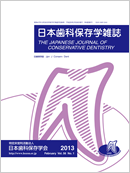Volume 50, Issue 1
Displaying 1-12 of 12 articles from this issue
- |<
- <
- 1
- >
- >|
Original Articles
-
Article type: Original Articles
2007 Volume 50 Issue 1 Pages 1-8
Published: February 28, 2007
Released on J-STAGE: March 31, 2018
Download PDF (1425K) -
Article type: Original Articles
2007 Volume 50 Issue 1 Pages 9-16
Published: February 28, 2007
Released on J-STAGE: March 31, 2018
Download PDF (1011K) -
Article type: Original Articles
2007 Volume 50 Issue 1 Pages 17-22
Published: February 28, 2007
Released on J-STAGE: March 31, 2018
Download PDF (1747K) -
Article type: Original Articles
2007 Volume 50 Issue 1 Pages 23-31
Published: February 28, 2007
Released on J-STAGE: March 31, 2018
Download PDF (1093K) -
Article type: Original Articles
2007 Volume 50 Issue 1 Pages 32-44
Published: February 28, 2007
Released on J-STAGE: March 31, 2018
Download PDF (2103K) -
Article type: Original Articles
2007 Volume 50 Issue 1 Pages 45-51
Published: February 28, 2007
Released on J-STAGE: March 31, 2018
Download PDF (843K) -
Article type: Original Articles
2007 Volume 50 Issue 1 Pages 52-61
Published: February 28, 2007
Released on J-STAGE: March 31, 2018
Download PDF (1275K) -
Article type: Original Articles
2007 Volume 50 Issue 1 Pages 62-67
Published: February 28, 2007
Released on J-STAGE: March 31, 2018
Download PDF (1423K) -
Article type: Original Articles
2007 Volume 50 Issue 1 Pages 68-74
Published: February 28, 2007
Released on J-STAGE: March 31, 2018
Download PDF (1071K) -
Article type: Original Articles
2007 Volume 50 Issue 1 Pages 75-79
Published: February 28, 2007
Released on J-STAGE: March 31, 2018
Download PDF (689K) -
Article type: Original Articles
2007 Volume 50 Issue 1 Pages 80-90
Published: February 28, 2007
Released on J-STAGE: March 31, 2018
Download PDF (3445K) -
Article type: Original Articles
2007 Volume 50 Issue 1 Pages 91-99
Published: February 28, 2007
Released on J-STAGE: March 31, 2018
Download PDF (2164K)
- |<
- <
- 1
- >
- >|
